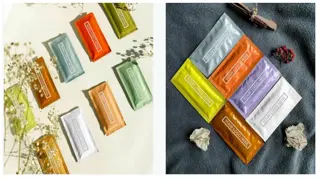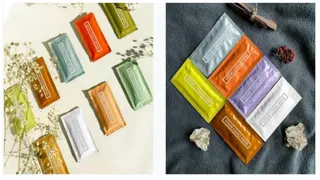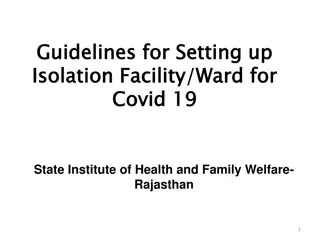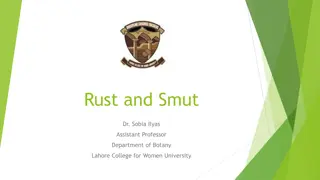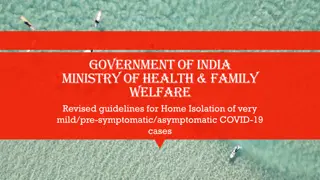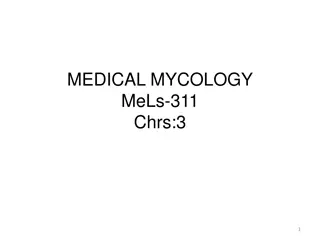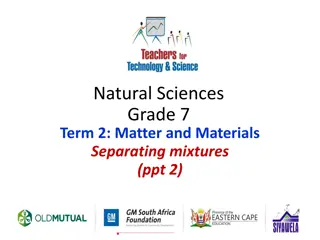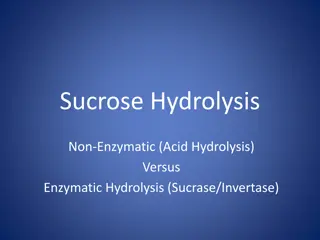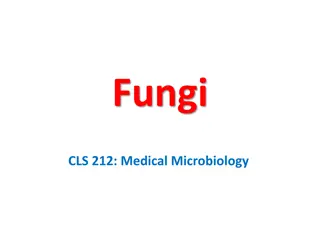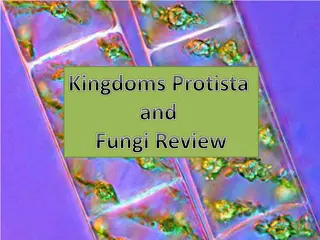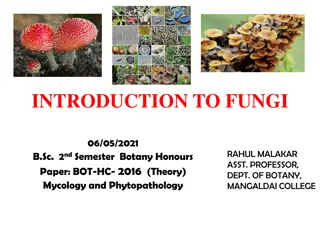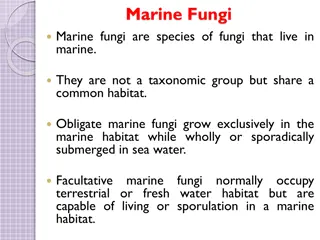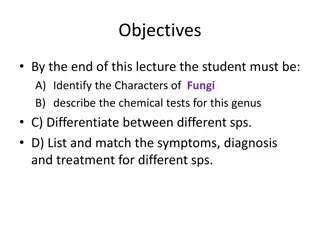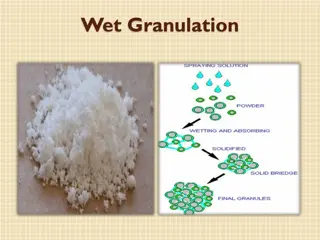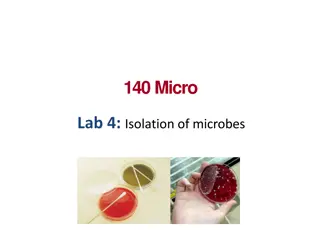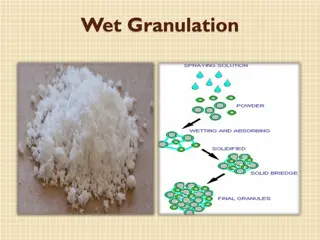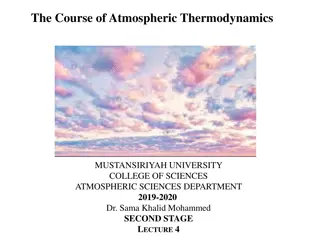Isolation of AM Fungi by Wet Sieving and Sucrose Gradient Methods
Wet sieving is a popular technique to isolate different sizes of spores from soil samples. Developed by Gerdemann and Nicolson in 1963, this method involves passing an aqueous suspension through different sieves to collect spores of varying sizes. The process includes agitating the soil-water mixture in a conical flask, allowing it to settle, and decanting the supernatant through sieves. The isolated spores are then picked out using a dissecting microscope. The technique has been refined over the years to effectively extract AM fungi spores for further study and application as biofertilizers.
Download Presentation

Please find below an Image/Link to download the presentation.
The content on the website is provided AS IS for your information and personal use only. It may not be sold, licensed, or shared on other websites without obtaining consent from the author. Download presentation by click this link. If you encounter any issues during the download, it is possible that the publisher has removed the file from their server.
E N D
Presentation Transcript
ISOLATION OFAM FUNGI BY WET SEIVING AND SUCROSE GRADIENT METHODS
Wet sieving method Also known as wet sieving and decanting method (Gerdemann and Nicolson, 1963). Developed to isolate different size of spores. The soil near the root system is collected and an aqueous suspension is passed through different sieves to collect spores of different sizes. The wet sieving and decanting is one of the popular technique when compare to other techniques. This technique is used for sieving the coarse particles of the soil and retaining AMF spores and organic particles on sieves of different sizes.10 g of soil was mixed with 100ml of water in the 500 ml conical flask. The soil mixture was agitated vigorously to free the AMF spores from soil and allowed to settle for 15-45 minutes and the supernatant was decanted through standard sieves. By using a dissecting microscope, spores were picked by means of pipette or needle.
Earlier, Gerdemann (1955) devised the first useful technique for extracting spores from soil. A soil sample was suspended in four times its volume of water, heavier particles were allowed to settle for a few seconds, then the liquid was decanted through a sieve with 1mm mesh. Whatever passed through this sieve was then poured through another sieve with 0.25 mm mesh. Material retained by this sieve was washed and transferred to a petridish, and the spores picked out by hand under a dissecting microscope. Technique given by Gerdemann (1955) was slightly refined by Gerdemann and Nicolson (1963) who used the following series of sieves: 1.0 mm ; 710 m; 420 m; 250 m; 149 m; 105 m; 74 m; and 44 m. They found that most of the desired spores fell in the 420- 149 m range, and they used this fraction for their study.
Source: https://www.slideshare.net/NawabKhatoon/mycorrhyzae-association
SIEVING METHOD Soil sample + sterile water Hot water Filter and sieve ( 719 m 250 m 50 m 45 m) Spores separated from soil particles Mix with carrier material Use when required as biofertilizer
FLOATATION METHOD Soil sample + sterile water Separate the soil particles using membrane filter Centrifuge ( Density gradient centrifuge = at 3000rpm for 30 min ) Spores separated from soil particles Mix with carrier material Use when required as biofertilizer
ISOLATIONOF VESICULAR-ARBUSCULAR MYCORRHIZAL (VAM) SPORESFROMTHESOIL Sieving method Requirements Soil sample 500 ml beaker Sieves of 710 m, 250 m, 75 m and 45 m. Bunsen burner
PROCEDURE Take 200 ml water in 500 ml beaker. Heat the water to 40-50 C. Add 50 g of soil and mix well to form a suspension. Allow the heavier particles to settle down. Decant most of the suspension through a 710 m sieve to remove large organic matter and roots. Add 200 ml of water to the suspension. Decant the suspension through 710 m sieve. Decant this through 250 m, 75 m and 45 m sieves consequently. Collect the residue on the 45 m sieve. Wash the residues well with water and collect the spore.
FLOATATIONMETHOD Requirements Soil sample Sucrose solutions (20, 40 and 60 %) Blender Fine sieve Centrifuge Centrifuge tube (50 ml)
PROCEDURE Collect fresh soil samples from the field, mix them well and weigh 20 g soil. Transfer the soil into a blender. Blend it at high speed for 1-2 minutes so that the spores attached to the soil particles or roots may become free. Filter the contents through a fine sieve and wash with strong stream of water. Pour 10 ml of 20% sucrose into a centrifuge tube followed by the same amount of 40% and 60% sucrose into the bottom of the tube. (Cont .)
Take 10-15 ml of blended sieving and add onto the surface of 20% sucrose layer. Centrifuge the contents for 3 minutes at 3000 rpm. Thereafter, remove the debris which accumulate at the interfaces of 20-40% and 40-60% of sucrose. Gently wash the spores present on fine sieve with a strong stream of water so that sucrose should be removed. Collect the spores and observe under microscope.
SUCROSEGRADIENTMETHOD Developed by Daniel and Skipper (1982); commonly used technique for AM spore extraction. Requires prior sieving and decanting. This modifications, right from Ohms (1957), Mosse and Jones (1968), Mertz et al. (1979) etc. gradient centrifugation method is result of many Spores were purified by re-suspending the sieving in the 40% sucrose solution and centrifugation was carried out. Centrifugation was carried out at 1750 rpm for 5 minutes. The supernatant was removed and poured into the sieves. The spores that hold on the sieves are carefully rinsed with tap water. The spores were collected by using dissecting microscope.
Mertz et al. (1979) protocol needs a special mention. They used discontinuous sucrose gradients to recover large number of spores from massive soil samples. They decanted and wet sieved 18 kg of soil with cold water, and found that most spores were present in the 425-250 m fraction. Spores were separated from most of the remaining debris using discontinuous 30% (w/v) aqueous sucrose gradients. The sieved material was layered on 600 ml water over 200 ml sucrose in 1 L beaker.After settling, the spores and debris that collected at the interface were removed by vacuum aspiration, rinsed in cold water, and centrifuged for 1- 5 min at 1600 X g in clinical centrifuge on a second gradient (15 ml water over 20 ml sucrose in a 50 ml tube), the duration of centrifugation being determined by the kind and amount of debris present.


